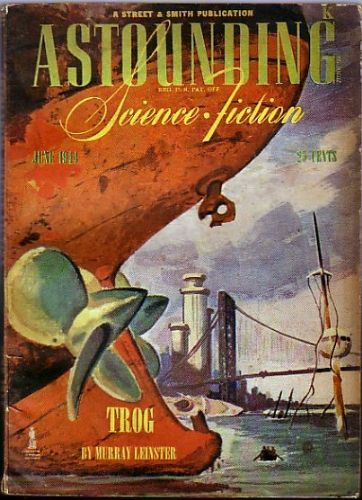Summary:
 After spotting an Outsider scouter beyond Pluto's orbit, Carson almost crashes into a planet. The g-forces cause him to black out. He awakes, naked, on a blue-sand planet--not even a planet, but a hemisphere bordered by force fields.
After spotting an Outsider scouter beyond Pluto's orbit, Carson almost crashes into a planet. The g-forces cause him to black out. He awakes, naked, on a blue-sand planet--not even a planet, but a hemisphere bordered by force fields.A voice enters his mind and tells him he must destroy the alien that is rolling in the sand. Roller, he calls his enemy. Carson makes a telepathic link with the Roller to make peace but fails. The Roller only wants to fight.
Analysis:They cannot get at each other directly, but by the Roller's killing and throwing a lizard, they learn the projectiles work fine. Carson has the stronger throwing arm and forces the Roller back. Carson, already parched, has a gash in his leg. He tries to patch it with local vegetation, but that only seems to make it worse. Meanwhile, the Roller has constructed a catapult. He manages to destroy it, but he is weakening. It makes another.
Later, he discovers that the Roller's de-legged lizard is actually alive. It was lack of consciousness that allowed through the barrier. Carson uses this information to cross the barrier and hopes the Roller throws a rock at him to revive him through pain. The Roller obliged Carson bides his time to attack.
Some interesting comparisons/contrasts with the Star Trek episode:
- The human is the stronger party in the story, the Roller more agile.
- No barrier in the TV episode. This also leaves them nothing but older, primitive technologies; whereas in the story, the barrier becomes a kind of technological tool if not a direct weapon.
- The story's lizard who is something of an indirect ally in the story becomes the enemy in Star Trek (although perhaps they are later allies--or at least, no longer enemies).
- The Trek episode works better as anti-war theme--both because the captains have a go and because Kirk chooses not to continue the fight to the death.
- However, what works better for the story was the importance of the little guy. SF is full of important, epic characters. Here, the little guy gets his chance at the limelight.

No comments:
Post a Comment